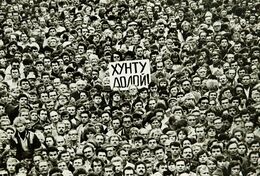Dissolution of the UPSR
This article is incomplete because it is pending further input from participants, or it is a work-in-progress by one author. Please comment on this article's talk page to share your input, comments and questions. Note: To contribute to this article, you may need to seek help from the author(s) of this page. |
| Part of End of the Great Game in Euclea | |
 "Down with the junta", a poster at a pro-democracy rally in Samistopol, 1980 | |
| Date | 1976–83 |
|---|---|
| Location |
|
| Outcome |
|
The dissolution of the UPSR, known also as the Autumn of Nations (Soravian: Осінь народів; Osin' narodiv), occurred gradually over the period of several years at the end of the 1970s and beginning of the 1980s. The constituent republics of the All-Soravian Union of Republics gained full sovereignty on January 8, 1983, according to the Instrument for Future Cooperation that was signed several months prior, with the UPSR officially ceasing to exist. Five nations succeeded the UPSR at various stages: Soravia (who acceded the UPSR in almost all its diplomatic commitments), Kantemosha and Ambrazka, Vedmed, Laudania and Bistravia.
A combination of economic and political stagnation towards the end of the Sytnikov era began to result in the beginning of protests and ethnic violence in the non-Marolevic parts of the union, which were met with forceful repression. When Aleksander Shelyapin became State Minister of the UPSR in 1971, he initially opted to continue violently suppressing these movements, but by the mid-1970s began to adopt a reformist stance towards these issues in the wake of continued political and economic decline. In coordination with his close ally Khatsiarelli Savinkov, who became Chief of Staff of the PDP in 1977, the ZVNP began to advocate for discussions on the futures of the non-Marolevic constituent republics, but remained determined to keep the Marolevic republics together. This ultimately resulted in the independence of Kantemosha in 1978 and Vedmed in 1979, though the former entered a sustained period of violence that resulted in the military occupation of the predominantly ethnically-Soravian Sarkola region in 1980.
The same year, the start of the Miersan War severely damaged the UPSR's reputation of military power abroad, with West Miersa brought to the brink of collapse with little aid from Samistopol. Beginning in 1981, leaders from the Bistravian and Belosoravian FSRs met with Shelyapin to begin talks that ultimately culminated in the introduction of the Instrument for Future Cooperation in June 1982, motivated majorly by growing fears of the spread of socialism to the UPSR, something that was already coming to fruition under Tagai Chulgetei's Zalyk independence movement. Hardliners of the party, led by Vilem Gardos, initiated the January 3 coup in an attempt to prevent the union's collapse. Successful for one day in occupying the Palace of the Republic in Samistopol, the perpetrators were eventually arrested. Due to the civil ending of the union, many ministries and old party networks were retained in the various newly-sovereign states, many of which came under major political influence from those in positions of power during the UPSR. Shelyapin superceded in his role as State Minister to become the first President of Soravia in 1983.
Violence in Zalykia continued until 1987, with Soravia and Shelyapin coming under widespread condemnation for its continued use of force in the region. The dissolution of the UPSR occurred in conjunction with other major political and social changes that marked the end of the Great Game in Euclea, including in the South Euclean People's Republic and Etruria. All of the states once part of the UPSR eventually became members of the Samistopol Cooperation Organisation, and many retain close political links to Samistopol, though in recent times there has been growing pro-eastern political developments in many of the central Euclean states.